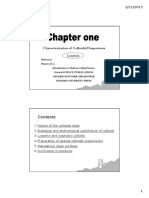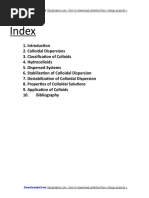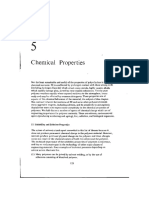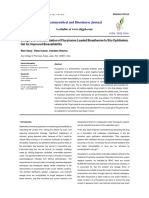0 ratings0% found this document useful (0 votes)
49 viewsMódulo 1 1.1 Coloides
This document provides an overview of colloids and their relevance to nanotechnology. It defines colloids as mixtures where one substance is microscopically dispersed within another. Colloids are distinguished from solutions, which involve molecules dispersed through solvation, and suspensions, where particles are larger. Many nanotechnology products involve colloidal systems. The document reviews different types of colloids based on the dispersed and continuous phases, such as emulsions, foams, and gels. It also discusses how the nanoscale affects properties like Brownian motion and stability.
Uploaded by
raulCopyright
© © All Rights Reserved
Available Formats
Download as PDF, TXT or read online on Scribd
0 ratings0% found this document useful (0 votes)
49 viewsMódulo 1 1.1 Coloides
This document provides an overview of colloids and their relevance to nanotechnology. It defines colloids as mixtures where one substance is microscopically dispersed within another. Colloids are distinguished from solutions, which involve molecules dispersed through solvation, and suspensions, where particles are larger. Many nanotechnology products involve colloidal systems. The document reviews different types of colloids based on the dispersed and continuous phases, such as emulsions, foams, and gels. It also discusses how the nanoscale affects properties like Brownian motion and stability.
Uploaded by
raulCopyright
© © All Rights Reserved
Available Formats
Download as PDF, TXT or read online on Scribd
You are on page 1/ 22
NT2001B -MANUFACTURE OF
NANOSTRUCTURES BY CHEMICAL METHODS
Module 1:
Fundamental aspects on the behavior of nanomaterials
DEPARTAMENTO DE CIENCIAS - QUÍMICA Y NANOTECNOLOGÍA
ESCUELA DE INGENIERÍA Y CIENCIAS
COLLOIDS
A Review
Dra. Yadira I. Vega
NT2001B - Nanomateriales por Métodos Químicos 2
WHAT IS A COLLOID?
➤Is a mixture in which one substance of
microscopically dispersed insoluble
particles is suspended throughout another
substance.
➤The term colloidal suspension refers
unambiguously to the overall mixture.
➤It’s composed by two phases:
➤Dispersed phase Example
➤Continuos phase
The mixture must not settle
https://en.wikipedia.org/wiki/Colloid
Dra. Yadira I. Vega
NT2001B - Nanomateriales por Métodos Químicos 3
WHY ARE COLLOIDS RELEVANT IN NANOTECHNOLOGY?
Many nanotechnology-based products involve colloidal systems!
Cosmetics
Quantum dots
Medical: vaccines & drugs
Advanced materials safety
Food and food supplements
Dra. Yadira I. Vega
NT2001B - Nanomateriales por Métodos Químicos 4
NANOSCIENCE AND COLLOIDS
➤ Nanoparticles in a liquid are colloidal
suspensions Nanoscale
effects
➤ Many dispersions of macromolecules are
colloidal suspensions, not true solutions
(e.g. proteins, some polymers)
➤ Smallsize of colloidal particles means that
the interfacial area is very large Smaller particles
Larger surface area
Larger interface
More stability
Surface characteristics (nanoscale effects) determine properties of the systems
Dra. Yadira I. Vega
NT2001B - Nanomateriales por Métodos Químicos 5
NANOPARTICLES: HIGH INTERFACIAL AREA, HIGH PERCENTAGE OF SURFACE ATOMS
➤ Number of surface atoms (A) in relation to total atoms (N)
increases exponentially with decreasing particle size
➤ Reactivity (chemical potential) also increases exponentially
(Image from: L. Brus “Semiconductor Nanocrystals, Kavli Prize Lecture”, Sept. 2008)
Dra. Yadira I. Vega
NT2001B - Nanomateriales por Métodos Químicos 6
A BRIEF REVIEW ON COLLOIDS
➤Ina colloid a substance in one phase
disperses into another, where the dispersed
phase is immiscible
➤Different from solutions which involve
small molecules (or atoms/ions) dispersed
by solvation into one homogeneous phase
➤Different from a suspension, in which
the particles of the dispersed phase are
larger than in a colloid. The suspension is
formed by agitation but will
segregate/sediment when left undisturbed
Dra. Yadira I. Vega
NT2001B - Nanomateriales por Métodos Químicos 7
WHAT IS THE EFFECT OF THE NANOSCALE ON BROWNIAN MOTION AND
When particles are at the nanoscale,
STABILITY OF COLLOIDS? Brownian motion is enough to
overcome the force of gravity and
colloid does not settle, thus, it’s
stable
Dra. Yadira I. Vega
NT2001B - Nanomateriales por Métodos Químicos 8
A solution is in one phase and stable
A colloid is a mixture (two
phases)of very small particles in
another substance, and it’s stable
A suspension is a mixture (two
phases)of larger particles in
another substance, and it’s NOT
stable
http://missbelmonte.weebly.com/solubility.html
Dra. Yadira I. Vega
NT2001B - Nanomateriales por Métodos Químicos 9
A BRIEF REVIEW ON COLLOIDS
➤The colloidal particles (discontinuous phase)
can be gaseous, liquid or solid
➤Particle sizes are in the range of 10–1000
nm
➤The dispersing phase (continuous phase) can
be gaseous, liquid or solid
➤When the continuous phase is a fluid
Brownian motion and convection currents
contribute to maintain the dispersed phase in
suspension
Dra. Yadira I. Vega
NT2001B - Nanomateriales por Métodos Químicos 10
TYPES OF COLLOIDS
Liquid - Gas Solid - Gas Gas - Liquid Liquid - Liquid
Liquid aerosols Solid aerosols foams emulsions
➡fog ➡smoke ➡shaving foam ➡milk
➡ hair spray ➡smog ➡whipped cream ➡mayonnaise
Dra. Yadira I. Vega
NT2001B - Nanomateriales por Métodos Químicos 11
TYPES OF COLLOIDS
Solid - Liquid Gas - Solid Liquid - Solid Solid - Solid
sol Solid foams gels
➡nanoparticles
➡blood ➡polymer foams ➡gelatine
in glass
➡Chinese ink ➡aerogels ➡agar
Dra. Yadira I. Vega
NT2001B - Nanomateriales por Métodos Químicos 12
GELS
A liquid-solid colloid that presents some resistance to deformation (low elasticity)
A gel can have:
•A covalent polymeric
https://news.wsu.edu/2014/06/30/super-absorbent-gel-could-help-farmers-save-water/ network
•A polymeric network by
aggregation due to
secondary bonding or
physical forces
https://www.delta.tudelft.nl/article/synthetic-gel-mimics-protoplasm
Dra. Yadira I. Vega
NT2001B - Nanomateriales por Métodos Químicos 13
TYPES OF GELS
➤Hydrogel
➤Gel where the fluid is water
➤Usually, the continuous network is a polymer
➤Organogel
➤Liquid in the gel is an organic solvent
➤Xerogel
➤Dry gel, usually made by evaporation of a solvent and
shrinkage
➤Aerogel
➤Gel from a micro or nano-porous solid, where the
disperse phase is a gas
➤Liquid in the gel is substituted by a gas without
shrinkage
➤The most used process involves supercritical drying
➤Freeze-drying can also be used
➤Dried by freezing and sublimation of a solvent at low
pressure
Dra. Yadira I. Vega
NT2001B - Nanomateriales por Métodos Químicos 14
LYOPHILIC VS LIOPHOBIC COLLOIDS
LYOPHILIC COLLOIDS LYOPHOBIC COLLOIDS
➤ Thermodynamically stable ➤ Thermodynamically unstable
➤ Precipitation of nanoparticles is a ➤ Precipitation of nanoparticles is not a
reversible process reversible process
➤ High viscosity ➤ Same viscosity as solvent
➤ Easy to prepare ➤ Difficult
to prepare, requires special
techniques and stabilizers:
➤ surfactants,polymers, organic
Most nanoparticles in suspension form
molecules (tiols, alcohols)
lyophobic colloids
Dra. Yadira I. Vega
NT2001B - Nanomateriales por Métodos Químicos 15
Dra. Yadira I. Vega
NT2001B - Nanomateriales por Métodos Químicos 16
ACTIVIDAD
Dra. Yadira I. Vega
NT2001B - Nanomateriales por Métodos Químicos 17
1 Instrucciones
Simulador de un sistema coloidal
El siguiente video muestra una simulación de un coloide de oro. Corre el siguiente simulador y contesta las preguntas en la siguiente sección:
Video from: https://youtu.be/wPaqDW5kEUc
Dra. Yadira I. Vega
NT2001B - Nanomateriales por Métodos Químicos 18
2 Contesta las siguientes preguntas
Sistema de oro coloidal
1.¿Cuál es el nombre del tipo de este sistema
coloidal?
2.¿Cómo se llama el movimiento que
presenta la nanopartícula de oro?
3.¿Porqué este movimiento es crucial para
mantener la estabilidad del sistema
coloidal?
4.¿Cuál el el límite de tamaño de partícula
que debe de tener el sistema para que se
mantenga estable?
5.¿Que son las moléculas en la superficie de
la nanopartícula de oro y para que se
utilizan?
6.¿Que otro tipo de sistemas coloidales
podrían ser representados por un simulador
parecido?
Dra. Yadira I. Vega
NT2001B - Nanomateriales por Métodos Químicos 19
1. Realiza la actividad en equipo
2. Prepara un documento con tus respuestas
3. Discute tus conclusiones con el resto del grupo y con tu profesor(a)
4. Ajusta tus respuestas
5. Sube tus respuestas a Canvas en el espacio indicado para esta actividad
Dra. Yadira I. Vega
NT2001B - Nanomateriales por Métodos Químicos 20
ACTIVIDAD
Dra. Yadira I. Vega
NT2001B - Nanomateriales por Métodos Químicos 21
INSTRUCCIONES
1.En equipo, elabora un resumen con los puntos más importantes del tema, tu
resumen debe de incluir:
a)¿Cuál es la definición de un coloide?
b)¿Qué se necesita para que un coloide sea estable?
c) Tomando en cuenta los efectos de superficie de nanopartículas, ¿porqué la mayoría
de los coloides de nanopartículas son lipofóbicos?
d)¿Qué se puede hacer para aumentar la estabilidad coloidal de nanopartículas?
2.La plata coloidal es una dispersión de nanopartículas en un solvente
1.Investiga su composición
2.¿Cómo es estabilizada esta formulación?
3. Prepara un documento con tus respuestas y súbelo a canvas en el espacio
indicado para esta actividad
Dra. Yadira I. Vega
NT2001B - Nanomateriales por Métodos Químicos 22
You might also like
- Chemical Engineering Univ. Sebelas Maret 2018No ratings yetChemical Engineering Univ. Sebelas Maret 201851 pages
- Colloidaldisp1pptcompatibilitymode 120521101209 Phpapp02 PDFNo ratings yetColloidaldisp1pptcompatibilitymode 120521101209 Phpapp02 PDF46 pages
- Colloidal Disp (1) - PPT (Compatibility Mode)No ratings yetColloidal Disp (1) - PPT (Compatibility Mode)46 pages
- CHM271 - Chapter 7 - Colloid - Surface ChemistryNo ratings yetCHM271 - Chapter 7 - Colloid - Surface Chemistry45 pages
- Topic 2 Colloidal States and Disperse SystemsNo ratings yetTopic 2 Colloidal States and Disperse Systems85 pages
- Colloidal Dispersion Systems: BY Dr. Musiba Baliruno Denis M.Pharm-Ind (Uon) 6 /02/2017No ratings yetColloidal Dispersion Systems: BY Dr. Musiba Baliruno Denis M.Pharm-Ind (Uon) 6 /02/201713 pages
- Colloids - Class 12 Chemistry Investigatory Project Free PDF DownloadNo ratings yetColloids - Class 12 Chemistry Investigatory Project Free PDF Download8 pages
- Milk, Butter, Cheese, Creams, Coloured Gems, Boot Polish, Rubber, Ink EtcNo ratings yetMilk, Butter, Cheese, Creams, Coloured Gems, Boot Polish, Rubber, Ink Etc18 pages
- My Publications - CHM 202-COLLOID & SURFACE CHEMISTRY-INo ratings yetMy Publications - CHM 202-COLLOID & SURFACE CHEMISTRY-I20 pages
- Colloidal Solutions: Department of Medical Chemistry Pomeranian Medical UniversityNo ratings yetColloidal Solutions: Department of Medical Chemistry Pomeranian Medical University34 pages
- Hydrophobic Colloids & Hydrophobic ColloidsNo ratings yetHydrophobic Colloids & Hydrophobic Colloids1 page
- Part 1. Colloidal Gel Formation & StructureNo ratings yetPart 1. Colloidal Gel Formation & Structure50 pages
- Biomedical Applications of Electroactive Polymer ActuatorsFrom EverandBiomedical Applications of Electroactive Polymer ActuatorsFederico CarpiNo ratings yet
- Formulation, Development and Evaluation of Instant Whitening Face WashNo ratings yetFormulation, Development and Evaluation of Instant Whitening Face Wash18 pages
- 6 - Review - Avances en Tipos de Hidrogeles y Remoción de ColorantesNo ratings yet6 - Review - Avances en Tipos de Hidrogeles y Remoción de Colorantes27 pages
- 1112impact of Petroleum Jelly On The Ageing of Telephone Wire FinalNo ratings yet1112impact of Petroleum Jelly On The Ageing of Telephone Wire Final6 pages
- Polymer-Based Hydrogels Applied in Drug Delivery: An OverviewNo ratings yetPolymer-Based Hydrogels Applied in Drug Delivery: An Overview38 pages
- Action of Microbial Transglutaminase (MTGase) in The Modification of Food Proteins - A ReviewNo ratings yetAction of Microbial Transglutaminase (MTGase) in The Modification of Food Proteins - A Review8 pages
- Zhang Et Al 2020 Versatile Surface Modification of Hydrogels by Surface Initiated Cu0 Mediated Controlled RadicalNo ratings yetZhang Et Al 2020 Versatile Surface Modification of Hydrogels by Surface Initiated Cu0 Mediated Controlled Radical7 pages
- Bulletin 01 - Polymers For Pharmaceutical ApplicationsNo ratings yetBulletin 01 - Polymers For Pharmaceutical Applications9 pages
- Nucleating Agent & Clarifier For Polyolefines: BenefitsNo ratings yetNucleating Agent & Clarifier For Polyolefines: Benefits2 pages
- The African Essentials - Presentation - O - 2019No ratings yetThe African Essentials - Presentation - O - 201934 pages
- 2009 - Confectionery Gels A Review On Formulation Rheological and Structural AspectsNo ratings yet2009 - Confectionery Gels A Review On Formulation Rheological and Structural Aspects36 pages
- Comprehensive Guidelines For The Application of In-Situ Polymer Gels For Injection Well Conformance Improvement Based On Field Projects 179575No ratings yetComprehensive Guidelines For The Application of In-Situ Polymer Gels For Injection Well Conformance Improvement Based On Field Projects 17957527 pages
- Crystal I I Zat I: ZyxwvutsrqponmlkjihgfedcbazyxwvutsrqponmlkjihgfedcbaNo ratings yetCrystal I I Zat I: Zyxwvutsrqponmlkjihgfedcbazyxwvutsrqponmlkjihgfedcba10 pages
- Chemical Properties: 5.1 Solubility and Solution PropertiesNo ratings yetChemical Properties: 5.1 Solubility and Solution Properties32 pages
- Product Design and Engineering Formulation of Gels and Pastes 1st Edition Ulrich Bröckel - The 2025 ebook edition is available with updated content100% (1)Product Design and Engineering Formulation of Gels and Pastes 1st Edition Ulrich Bröckel - The 2025 ebook edition is available with updated content47 pages
- Design and Characterization of Flucytosine Loaded Bioadhesive in Situ Ophthalmic Gel For Improved BioavailabilityNo ratings yetDesign and Characterization of Flucytosine Loaded Bioadhesive in Situ Ophthalmic Gel For Improved Bioavailability4 pages
- Innovative Methods For The Removal, and Occasionally Care, of Pressure Sensitive Adhesive Tapes From Contemporary DrawingsNo ratings yetInnovative Methods For The Removal, and Occasionally Care, of Pressure Sensitive Adhesive Tapes From Contemporary Drawings16 pages
- Colloidaldisp1pptcompatibilitymode 120521101209 Phpapp02 PDFColloidaldisp1pptcompatibilitymode 120521101209 Phpapp02 PDF
- Colloidal Dispersion Systems: BY Dr. Musiba Baliruno Denis M.Pharm-Ind (Uon) 6 /02/2017Colloidal Dispersion Systems: BY Dr. Musiba Baliruno Denis M.Pharm-Ind (Uon) 6 /02/2017
- Colloids - Class 12 Chemistry Investigatory Project Free PDF DownloadColloids - Class 12 Chemistry Investigatory Project Free PDF Download
- Milk, Butter, Cheese, Creams, Coloured Gems, Boot Polish, Rubber, Ink EtcMilk, Butter, Cheese, Creams, Coloured Gems, Boot Polish, Rubber, Ink Etc
- My Publications - CHM 202-COLLOID & SURFACE CHEMISTRY-IMy Publications - CHM 202-COLLOID & SURFACE CHEMISTRY-I
- Colloidal Solutions: Department of Medical Chemistry Pomeranian Medical UniversityColloidal Solutions: Department of Medical Chemistry Pomeranian Medical University
- Biomedical Applications of Electroactive Polymer ActuatorsFrom EverandBiomedical Applications of Electroactive Polymer Actuators
- Formulation, Development and Evaluation of Instant Whitening Face WashFormulation, Development and Evaluation of Instant Whitening Face Wash
- 6 - Review - Avances en Tipos de Hidrogeles y Remoción de Colorantes6 - Review - Avances en Tipos de Hidrogeles y Remoción de Colorantes
- 1112impact of Petroleum Jelly On The Ageing of Telephone Wire Final1112impact of Petroleum Jelly On The Ageing of Telephone Wire Final
- Polymer-Based Hydrogels Applied in Drug Delivery: An OverviewPolymer-Based Hydrogels Applied in Drug Delivery: An Overview
- Action of Microbial Transglutaminase (MTGase) in The Modification of Food Proteins - A ReviewAction of Microbial Transglutaminase (MTGase) in The Modification of Food Proteins - A Review
- Zhang Et Al 2020 Versatile Surface Modification of Hydrogels by Surface Initiated Cu0 Mediated Controlled RadicalZhang Et Al 2020 Versatile Surface Modification of Hydrogels by Surface Initiated Cu0 Mediated Controlled Radical
- Bulletin 01 - Polymers For Pharmaceutical ApplicationsBulletin 01 - Polymers For Pharmaceutical Applications
- Nucleating Agent & Clarifier For Polyolefines: BenefitsNucleating Agent & Clarifier For Polyolefines: Benefits
- 2009 - Confectionery Gels A Review On Formulation Rheological and Structural Aspects2009 - Confectionery Gels A Review On Formulation Rheological and Structural Aspects
- Comprehensive Guidelines For The Application of In-Situ Polymer Gels For Injection Well Conformance Improvement Based On Field Projects 179575Comprehensive Guidelines For The Application of In-Situ Polymer Gels For Injection Well Conformance Improvement Based On Field Projects 179575
- Crystal I I Zat I: ZyxwvutsrqponmlkjihgfedcbazyxwvutsrqponmlkjihgfedcbaCrystal I I Zat I: Zyxwvutsrqponmlkjihgfedcbazyxwvutsrqponmlkjihgfedcba
- Chemical Properties: 5.1 Solubility and Solution PropertiesChemical Properties: 5.1 Solubility and Solution Properties
- Product Design and Engineering Formulation of Gels and Pastes 1st Edition Ulrich Bröckel - The 2025 ebook edition is available with updated contentProduct Design and Engineering Formulation of Gels and Pastes 1st Edition Ulrich Bröckel - The 2025 ebook edition is available with updated content
- Design and Characterization of Flucytosine Loaded Bioadhesive in Situ Ophthalmic Gel For Improved BioavailabilityDesign and Characterization of Flucytosine Loaded Bioadhesive in Situ Ophthalmic Gel For Improved Bioavailability
- Innovative Methods For The Removal, and Occasionally Care, of Pressure Sensitive Adhesive Tapes From Contemporary DrawingsInnovative Methods For The Removal, and Occasionally Care, of Pressure Sensitive Adhesive Tapes From Contemporary Drawings

























































































